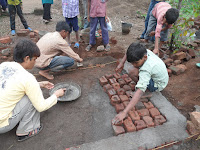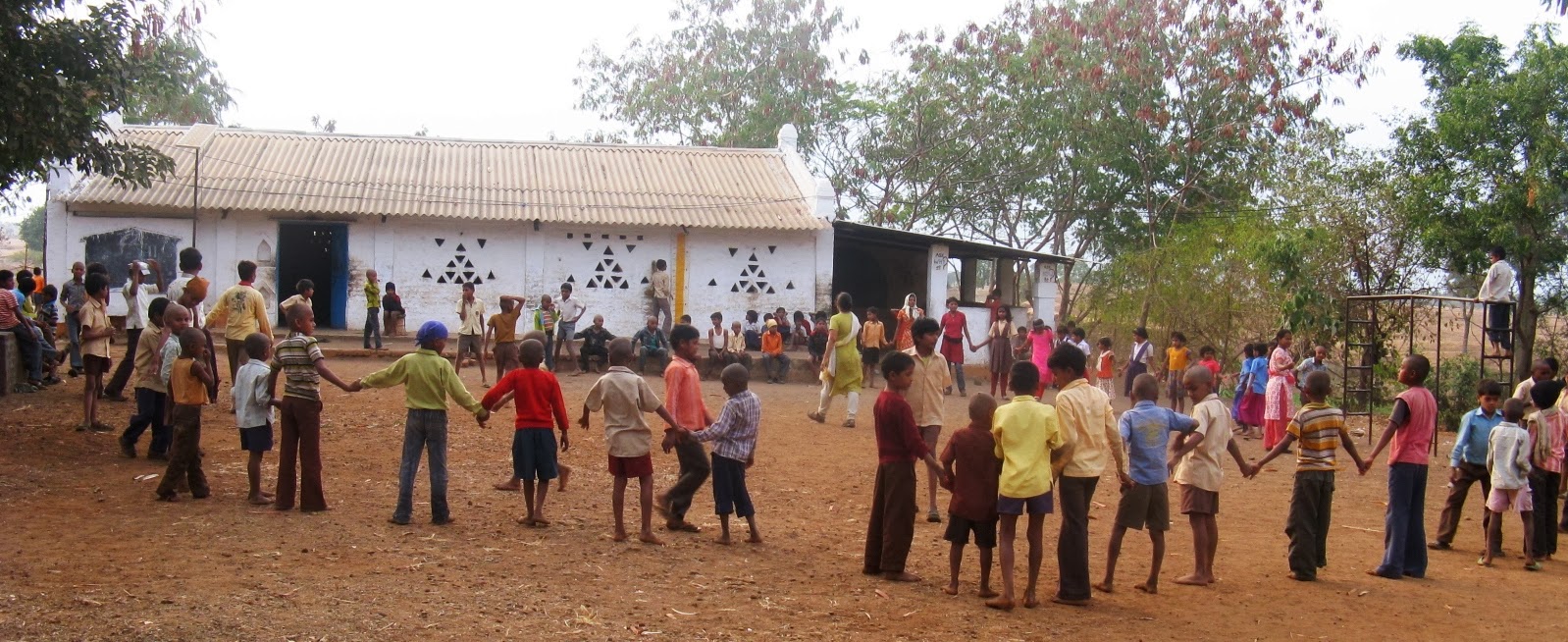June – November 2011
 The academic session started with the first hand experience of rubbing shoulders with the regular school system. We were trying to admit our son in the 10th class, who was in Adharshila (an unrecognized learning centre) for the first 9 years. The papers, affidavits and all. We experienced the anguish of the hapless adivasi parents who have to run for the various certificates from panchayats to tehsils for months to get their children admitted. The photocopy shops make a heist. In this month farmers are running in search of two things - seeds and loans for the farm and certificates and hostels for the kids.
The academic session started with the first hand experience of rubbing shoulders with the regular school system. We were trying to admit our son in the 10th class, who was in Adharshila (an unrecognized learning centre) for the first 9 years. The papers, affidavits and all. We experienced the anguish of the hapless adivasi parents who have to run for the various certificates from panchayats to tehsils for months to get their children admitted. The photocopy shops make a heist. In this month farmers are running in search of two things - seeds and loans for the farm and certificates and hostels for the kids. Even though the rains tested every body’s patience the meeting for new admissions was a moral booster. New, excited children and parents. Nice way to forget those who have decided to leave. Even more encouraging this year was the group of people who wanted to open a new centre in Roshmal. Kukna an AMS activists mobilized parents of 3 villages to start a Centre in their village. He listed 35 parents, keen to start the new centre, formed a committee to manage the school and brought them to Adharshila for a one day meeting with us to understand the philosophy and structure of Adhrshila. Ultimately this didn’t work out as they couldn’t find anybody to run the centre. But it resulted in two young boys and girls coming to Adharshila for the teacher training program while studying for the 10th exam from open school. We hope they will be able to run such children’s centres after one or two years – a future plan. The children of Sakad village took lots of vegetable seeds and some tree plants for their homes.
 The 4th issue of Yuvaniya, a magazine for youth came out. We established a good rapport with the workers of Muskaan, an NGO working with Gond children in Bhopal slums who came to help in typing and editing the issue. We are currently working on the 5th issue, a special issue for the Adivasi Ekta Sammelan to be held in Rajasthan in January. We are after the main leaders of the Ekta Parishad to write for the issue. Through Yuvaniya, 4 writing workshops for adivasis were conducted from where most of the material for the magazine was generated.
The 4th issue of Yuvaniya, a magazine for youth came out. We established a good rapport with the workers of Muskaan, an NGO working with Gond children in Bhopal slums who came to help in typing and editing the issue. We are currently working on the 5th issue, a special issue for the Adivasi Ekta Sammelan to be held in Rajasthan in January. We are after the main leaders of the Ekta Parishad to write for the issue. Through Yuvaniya, 4 writing workshops for adivasis were conducted from where most of the material for the magazine was generated. |
| Kamal |
Children are encouraged to participate in social and political events in the area. The Adharshila children’s song and dance troupe performed at two adivasi sammelans in Maharashtra and MP. Right now also they have gone to Zoida village in Maharashtra. Maybe the Naatak India Company will get to perform in Rajasthan. We are still trying to get sponsors ( hint for SRUTI ). The children performed a play in the school on 15th August, depicting the story of Independence. The senior students participated in two rallies held in Sendhwa and Pansemal. Two teachers also attended programs of an adivasi organization in the Pati block.
Adharshila has been taking up the role of training teachers of community schools. In the first half this year 5 trainings were held. Two in the Kakrana School in Alirajpur district. Two boys from Burhanpur stayed here for a month for teacher training to help in the Burhanpur School. One training cum meeting was organized for adivasi teachers of five schools run by adivasi sangathan/communities. 15 teachers from the 5 schools participated. A great feeling of camraderie was felt amongst the teachers. Some common programs were decided – drawing workshops and folk story documentation. About 50 folk stories were collected in these schools in 3 districts. A Kahani Marathon was conducted at Adharshila where about 60 children, age 8 years – 18years and some villagers narrated stories for about 4 days, two hours everyday. About 15 children made illustrated books out of their stories. Hopefully we will be able to print a collection of some of these stories by the end of this academic year.
In this vein three student teachers from Adharshila volunteered for a month at a remote school run by Jagrut Adivasi Dalit Sangathan in Barwani District. We too were invited to take a course at TISS, Tuljapur to do an Educations Skills course for the final year BSW students. It was interesting to compare there infrastructure with ours both for 150 children. Jayashree conducted a women’s training for the Satna group voluntarily.
Lot of work on basic curriculum development was completed. Most of the math curriculum for the primary and some modules for the middle schools were made thanks to Mansi. Work on English and Hindi language primers also went ahead. Jayashree tried her hand at illustrations quite successfully. Two interns from TISS, Mumbai, doing Masters in Elementary Education helped document two social science modules one each in Geography and History.
Vibhore was with us for 3 months intermittently, under the Adharshila Fellowship Program. While volunteering he was engaged in thinking about the question of bringing social change through education.
This year a poultry was started by the two students who went for training in the summers. So now we have an organic farm, cattle shed and poultry, looked after by the children under the guidance of adults. The poultry has more than 50 birds, starting with 7. the organic farm has given us about 4 quintal veggies uptil now. This year we also have a papaya plot. These activities are important for us as one of the basic premise of this educational program is that we – adults and children - should engage in the activities that are done by the villagers. One group has made a potato plot for themselves. Another group developed a herbal garden which lasted for 4 months.
 | |
| Students and teachers constructing the hen cage |
 | ||
| Our newest residents |
 | |
| Field preparation |
 |
| Group fertilizer preparation |
Some friends insist on coming to Adhrshila and they claim that they get a lot of inspiration. One such group is INSPIRE who bring NRI children to see the ‘real’ India. People from two NGOs also visited us. A group of villagers who wanted to start a school also stayed for a day. Some businessmen from Indore visited the ‘Sakad Ashram’ through some other friends. And lastly these days we have the annual visitor the Wagtail from the Himalayas.
Construction of a kitchen extension shed was done and the mess hall was partitioned to make two rooms.
We are 100 children and nine adults. A group of 8 senior children help Shevanta, Shanta and Badri bhai manage the show. This year almost all the day scholars have vanished due to the RTE and the stipend being given to children.





















